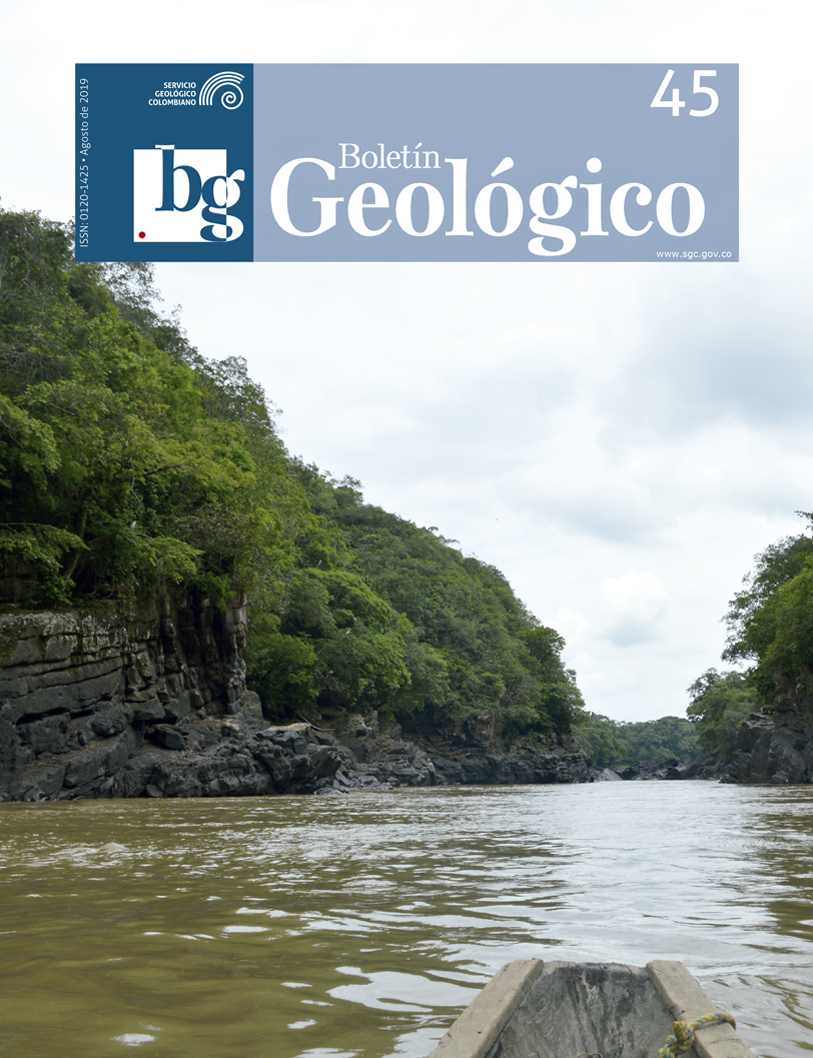Analysis of geobotanical anomalies from the processing and interpretation of remote sensing products: Case study of West Boyacá (Colombia)
DOI:
https://doi.org/10.32685/0120-1425/boletingeo.45.2019.485Keywords:
Vegetation indices, geobotanical anomalies, spectral analysis, emerald, remote sensingDownloads
How to Cite
Issue
Section
Published
Abstract
This work presents the boundaries of a new area of interest for the detailed exploration of emeralds in Colombia, identified through the interpretation of geobotanical anomalies in areas of dense vegetation. A methodology was designed in which fifteen vegetation indices were calculated. The anomalies correlated most with the lineaments detected from the interpretation of a shaded-relief model generated from a digital terrain model (DTM) were selected. A detailed spectral analysis in the mineralized zones of the area with the highest correlation showed a halo of vegetative stress in all studied cases; moreover, the analysis corroborated a direct relationship between the albitization present in the mineralized zones, the lineaments and the degree of vegetative stress. A sector between the Coscuez mine and the La Pita mine was identified as a target for detailed exploration, where the vegetation indexes indicate less vegetative stress and correlate better with the natural terrain lineaments. It was found that the proposed methodology based on geobotanical anomalies yields consistent results and can be used as a tool for emerald exploration.
References
Biologydictionary.net. (2017). Chlorophyll. Consultado el 8 de septiembre de 2017 en https://biologydictionary.net/chlorophyll
Camacho Velasco, A., Vargas-García, C., Rojas-Morales, F., Castillo-Castelblanco, S. y Arguello-Fuentes, H. (2015). Aplicaciones y retos del sensado remoto hiperespectral en la geología colombiana. Revista Facultad de Ingeniería, 24 (40), 17-29. Doi:
https://doi.org/10.19053/01211129.3845.
Crosta, A. (1989). Enhancement of Landsat thematic mapper imagery for residual soil mapping in SW minais Gerrain. Proceedings of the 7th (ERIM) Thematic Conference: Remote sensing for exploration geology Calgary. Calgary.
European Spatial Agency (2017). Consultado el 26 de septiembre de 2017 en http://www.esa.int/ESA.
Geoportal IDEAM (s. f.). Consultado el 27 de septiembre de 2017 en https://www.datos.gov.co/Ambiente-y-Desarrollo-Sostenible/Catalogo-Estaciones-IDEAM/n6vw-vkfe/data.
Heldt, H. W. (1997). Plant biochemistry and molecular biology. Oxford: Oxford Uninversity Press.
Mendoza Parada, J. (1996). Anotaciones geoquímicas para exploración de esmeraldas en la región Muzo-Coscuez con base en la relación Na/K y elementos traza. Geología Colombiana, 21, 89-98.
Milgrom, L. R. (1997). The colours of life: An introduction to the chemistry of porphyrins and related compounds. Oxford: Oxford University Press.
Prieto, J., González Ramírez, C. A., Román Gutiérrez, A. D. y Prieto García, F. (2009). Contaminación y fitotoxicidad en plantas por metales. Tropical and Subtropical Agroecosystems, 10 (1), 19-44.
Prol Ledesma, R. M. y Ruiz-Armenta, J. R. (1995). Técnicas de procesamiento de imágenes en la exploración de yacimientos minerales de origen hidrotermal. Física de la Tierra, 7, 105-137.
Ross, J. (1981). The radiation regime and architecture of plants stands. Londres: Springer. Doi: https://doi.org/10.1007/978-94-009-8647-3.
Sahuquillo, A., Rigol, A. y Rauret, G. (2003). Overview of the use of leaching extraction tests for risk assessment of trace metals in contaminated soils and sediments. Trends in Analytical Chemistry, 22 (3), 152-159. Doi: http://doi.org/10.1016/S0165-9936(03)00303-0.
Singer, M. (2015). Photophosphorylation: The light reactions in photosynthesis. OpenStax CNX. Consultado en https://cnx.org/contents/-CmzvUct@12/The-Light-Dependent-Reactions-of-Photosynthesis.
Souza Filho, C., Augusto, V., Oliveira, W. J. y Lammoglia, T. (2008). Detecção de exsudações de hidrocarbonetos por geobotânica e sensoriamento remoto multi-temporal: estudo de caso no Remanso do Fogo (MG). Revista Brasileira de Geociências, 38 (1, sup. 2), 228-243.
Towers, P. C. y von Martini, A. (2002). Conceptos iniciales sobre teledetección y su aplicación al agro. Buenos Aires: AgriSat.
Ujueta, G. (1992). Lineamientos río Ariari, Bogotá y Gachalá, en los departamentos de Cundinamarca y Meta, Colombia. Revista Academia Colombiana de Ciencias Exactas, Físicas y Naturales, 18 (70), 345-358.
Unidad de Planeación Minero-Energética (2014). Plan Nacional de Desarrollo Minero. Bogotá: Ministerio de Minas y Energía.
Van der Meer, F. (2006). The effectiveness of spectral similarity measures for the analysis of hyperspectral imagery. International Journal of Applied Earth Observation and Geoinformation, 8 (1), 3-17. Doi: https://doi.org/10.1016/j.jag.2005.06.001.
Xue, J. y Su, B. (2017). Significant remote sensing vegetation indices: A review of developments and applications. Journal of Sensors, 2017. Doi: https://doi.org/10.1155/2017/1353691.









